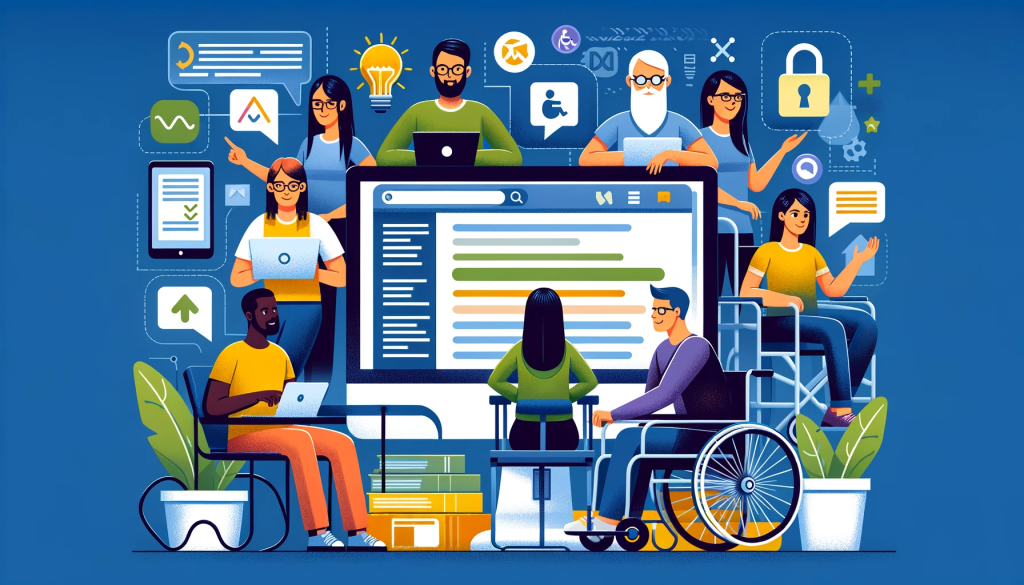Accessibility, the often-neglected middle child of digital media, is a lot more important for websites, apps, etc. than it might appear at first glance. Of course, this idea of “accessibility” refers to designing content that is usable and legible for all users, including those with disabilities and visual impairments.1 But why should companies and businesses care about what may seem to be a niche market? Is it even worth the effort?
To start with, ensuring accessibility is THE RIGHT THING TO DO, but that type of reasoning would hardly convince most corporations. The more “business” minded individuals should be reminded that accessible content expands your potential customer base and sets the tone on the corporation’s stance on inclusiveness. Furthermore, accessible websites improve said website’s search engine optimization. Isn’t that neat? Most importantly, accessibility isn’t a suggestion, it’s the law.2
In the United States, under the accessibility and the Americans with Disabilities Act (ADA), websites and apps can be considered places of public accommodation.3 In consequence, if a website fails to meet the criteria which deem it to be accessible, they are in danger of being sued from their users. The last thing you want is an onslaught of fines and lawsuits because of your website’s inaccessibility.
How do you make your website accessible?
Ideally, one must follow the Web Content Accessibility Guidelines (WCAG), the universal standard for website accessibility from W3C.4 It would be an arduous task to detail the entirety of the guidelines, but the WCAG standards are rooted in their four main principles: perceivable, operable, understandable, and robust. Also known as POUR .5
Once a site is deemed to meet a certain level of conformity among the WCAG, they will be awarded one of three levels: A, AA, and AAA.6 A being the minimum level any website should meet, AA representing strong accessibility, and AAA is awarded only to sites that provide exceptional accessibility.7 It isn’t feasible for every site to reach the AAA or even AA status, but owners and managers should ensure that their sites are at minimum A level, even if it is just to prevent legal issues.
How hard is it to make a site accessible?
With the advent of WCAG testing, many federal agencies, major corporations, and large businesses, now have entire departments dedicated to ensuring said accessibility among their digital libraries. For small businesses, this approach isn’t recommended, as WCAG testing may range from minor issues such as the contrast of the font and background, to in-depth cases involving how the site navigates without the use of the mouse, keyboard, or other tools. Nonetheless, basic concepts should be kept in mind when designing the site.
Here are the recommendations from the WCAG page:8
- Ensure form-entry functions have either no time limit or an extended time limit for those who need more time.
- Provide consistent elements, including navigation features, headers, footers, and sidebars, across all web pages. This consistent approach helps ensure end users can easily find these elements on any webpage.
- Make your website navigable without using a mouse—the keyboard “tab” button, alone, should enable end users to navigate any page on your website.
- Provide a proper, clearly identifiable content level structure for screen reader users.
- Use proper contrast ratios between foreground text and background colors for those with vision-related disabilities.
- Avoid design elements that may induce seizures. For example, no website element should flash more than three times in a one-second interval.
- Help users prevent and fix their mistakes. For example, provide text descriptions of all automatically detected errors.
- https://dap.berkeley.edu/learn/what-digital-accessibility ↩︎
- https://bigsea.co/ideas/accessibility-digital-marketing/ ↩︎
- https://heinonline.org/HOL/LandingPage?handle=hein.journals/indana95&div=19&id=&page=%20- ↩︎
- https://digitalmarketinginstitute.com/blog/digital-accessibility-what-marketers-need-to-know ↩︎
- https://www.wcag.com/resource/what-is-wcag/ ↩︎
- Ibid. ↩︎
- Ibid. ↩︎
- Ibid. ↩︎
